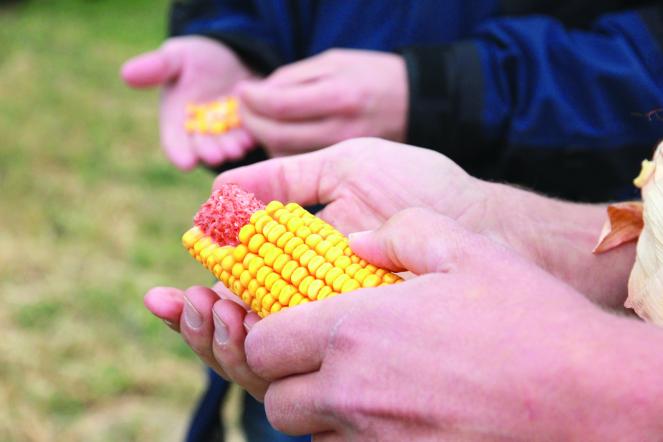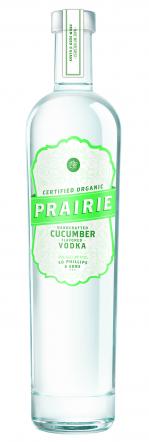“Organic” isn’t a word I usually associate with vodka. Sure, organic is commendable. Organic is responsible. Organic is even noble.
But these homespun virtues don’t exactly dovetail with vodka’s typically glitzy image. Commercials for big-name vodkas often beguile the viewer with fussy fantasy worlds that feature dazzling women, surreal Norse landscapes, ice palace discos, and fashion runways a-pop with camera flashes.
Could “organic” even get past the doorman?
The folks who make Prairie Organic Vodka don’t seemed concerned with such questions, at least if their advertisements are any indication. They feature a bottle of their spirits sitting on a tree stump. Sexy? Maybe to another tree.
Instead, substance, not style, is the philosophy behind Prairie Organic Vodka. It’s produced by Phillips Distilling Company, a century-old establishment in Minneapolis that also makes Feckin Irish Whiskey, Cabrito Tequila, and UV Vodka.
Phillips launched Prairie Organic Vodka in 2008 as a luxury brand that, according to company promotional materials, would pay tribute to Minnesota’s agricultural heritage. The folks at Phillips proudly tout the horse and buggy approach to making their Prairie brand, which also include Prairie Organic Gin and Prairie Cucumber-Flavored Organic Vodka.
The makers of Prairie Organic Vodka certainly seem to have checked all the boxes on the green list - it’s locally produced, using sustainable methods, organic ingredients, and no pesticides. It’s distilled at a co-op in Benson that is owned by more than 900 farmers, who are all stakeholders in the Prairie Organic Brand. Each batch is distilled in limited quantities to taste, not a prescribed number of times, plus it's USDA certified organic.
 Prairie Organic Corn
Prairie Organic Corn
The corn is grown on three organic farms - Sather Organic Farms, Little Big Man Organic Farms, and Olson Organic Farms. In order to earn USDA organic certification, the corn seeds cannot be genetically modified. If you want vodka made fast, go somewhere else. Before the corn can even be planted, the soil must be cleansed of contaminants and given time to let the natural nutrients regenerate themselves. This process can take up to three years.
In keeping with their green ethos, the farmers rely on birds and bats to help control the insect population, thus ensuring you won’t be sipping any pesticides with your vodka on the rocks. They also rotate their corn crops to stay one step ahead of destructive white grubs and corn flea beetles, and they control weeds through old-fashioned prairie fires.
Just as microbrewers rebelled against the mass-produced beers advertised on ESPN, craft distillers are mounting a farm-to-bar movement that’s nudging bartenders into the role of chefs. At Heartland Restaurant & Farm Direct Market in St. Paul, Prairie Organic Spirits are mixed in craft cocktails with fresh herbs, locally produced bitters, and juices made on-site from ginger or apples.
Executive chef Lenny Russo, who’s sampled more than a few different kinds of vodka from around the world, says he’s impressed by Prairie’s distinctive flavor. He points out that it’s distilled as many times as necessary, based on the particular characteristics each batch, with the distillation process run as sustainably as possible. For example, the stills are fueled in part by leftover corncobs.
“The fact that it’s done in a sustainable fashion fits our philosophy,” says Russo, a James Beard Foundation Award nominee. “They’re using the whole (corn) plant. They’re using biomass from what’s left over to power the actual distiller. When the mash is spent, that’s being recycled into feed for animals.”
 Russo says that Prairie Cucumber-Flavored Organic Vodka is
his personal favorite. No mixing required. “I don’t do anything to that,” Russo
explains. “I drink that on the rocks. It’s very clean and easy to work with. It’s
easy to mix.”
Russo says that Prairie Cucumber-Flavored Organic Vodka is
his personal favorite. No mixing required. “I don’t do anything to that,” Russo
explains. “I drink that on the rocks. It’s very clean and easy to work with. It’s
easy to mix.”
But all this sustainability would still mean zilch if it didn’t taste good To me, the vodka has a smooth, silky taste. Vodka normally is distilled from potatoes, wheat, or other grains; the certified organic #2 yellow corn that goes into the Prairie vodka imparts a fresh, velvety mouth feel that teases the tongue with an elusive suggestion of fruit. Prairie Organic Gin, which debuted in July, is also a standout. Gin is gin is gin, right? You might think so, but it’s not always the case. I’ve sworn off gin for reasons I won’t go into here, but Prairie Organic Gin had a refreshingly clean taste that just might lure me back. Jim Aune, director of research and development for Phillips, said they make their gin with coriander lemon, cassia, angelica, and a hint of juniper.
If you’re into flavored vodkas, the Prairie website provides several recipes, including how to make infused vodkas such as Strawberry/Basil, Lemon/Lime, and Espresso/Cinnamon. Here are a few more cocktail recipes, courtesy of Prairie, to get you started.
Red Hawk
Ingredients:
- 1 ½ oz Prairie Organic Vodka
- 1 ½ oz pomegranate juice
- A squeeze of fresh lemon juice
Instructions:
- Shake over ice and strain into a martini glass. Garnish with a fresh mint leaf.
Garden Martini
Ingredients:
- 2 oz Prairie Organic Gin
- 2 teaspoons dry vermouth
- 1 rosemary sprig
- 3 pitted olives
Instructions:
- Combine gin, dry vermouth and ice in shaker. Shake comfortably. Strain into martini glass. Strip leaves from bottom half of rosemary sprig and skewer olives to garnish drink.
Cucumber Mojito
Ingredients:
- 2 parts Prairie Cucumber Flavored Vodka
- 1 part fresh squeezed lime juice
- 2 tsp. sugar
- 6 fresh mint leaves
Instructions:
- Muddle mint, sugar and lime juice in a Collins glass. Fill with ice, add vodka and top with soda water. Shake or mix and garnish with a cucumber wedge.

William Loeffler moved to the Twin Cities area from Pittsburgh, Pennsylvania, where he spent 15 years as a features reporter for the Pittsburgh Tribune-Review. A playwright, he has also interviewed Bill Cosby, Yoko Ono and Eric Idle. He has written about his travels to all seven continents as well as his experiences running seven Boston Marathons. His last post for SGT was Gray Duck Chai Takes Flight in the Twin Cities.

